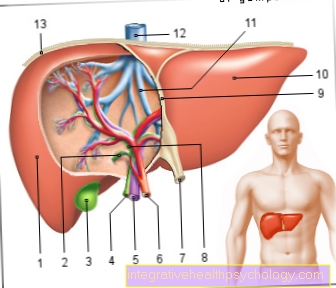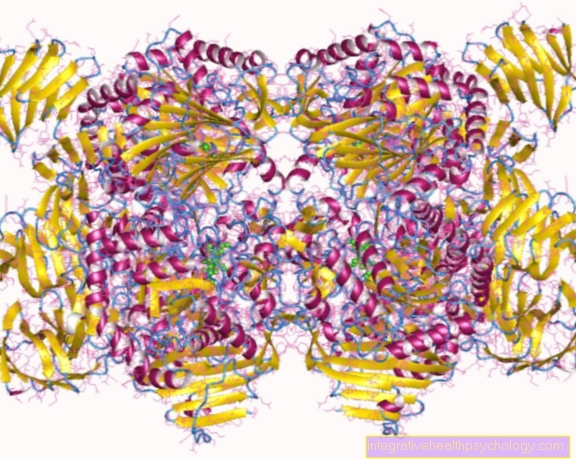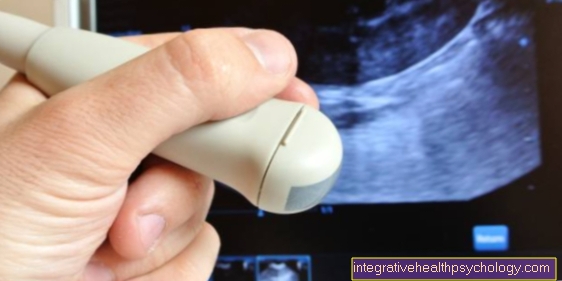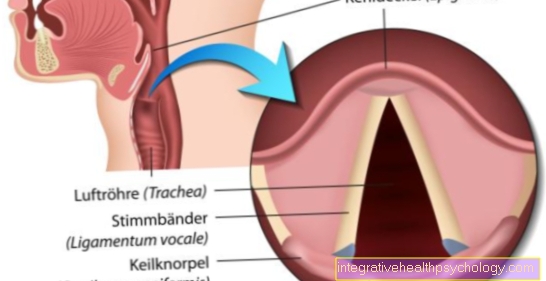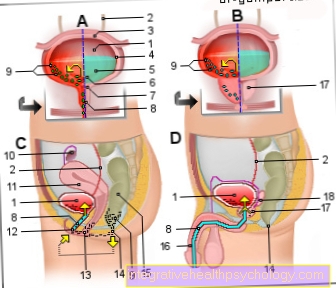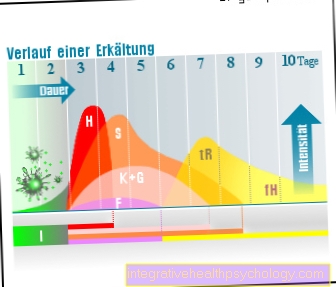Crown for an incisor
introduction
On the one hand, an incisor crown is the natural tooth crownthat protrudes into the oral cavity, to the other that of the dentist artificially made crownthat acts as a denture. The tooth must be ground before the artificial crown is produced on a model.

At the end this is cemented firmly to the tooth stump. The costs depend on the material used and the size of the restoration. They are only partially covered by the health insurance company.You receive a little more subsidy with a consistently managed bonus booklet.
root cause
An incisor crown is always necessary when there is not enough of your own hard tooth substance. Tooth hard substance includes enamel, dentin and root cement. This is the case, for example, with several large-area fillings on the affected tooth. Here, a renewed filling measure would allow insufficient adhesion and increase the risk of tooth breakage when biting off.
Read more on the topic: Tooth structure
The cause of the loss of hard substance can be a carious lesion or, especially in the case of the incisors, trauma. A trauma describes an injury that, in this case, results from a fall on the cutting edge or from a blow in the face. It is possible that incisors break off well below the level of the gums. The only chance of salvation then lies in the crown.
In addition to excessive loss of hard tooth substance, there are other reasons that require crowning. This measure is necessary, for example, after a root canal treatment or to incorporate a bridge. The position of the teeth can also be changed using an incisor crown. One tooth is then adapted to the other in order to achieve an optical improvement.
Read more on the topic: Caries
diagnosis
The dentist can usually see at first glance whether an artificial crown is necessary. For the diagnosis a Percussion- and Cold test performed to test the vitality of the tooth. During a percussion test, the dentist gently taps the teeth with the lower end of the mirror. If the teeth are healthy, this should not cause pain. During a cold test, the dentist holds a small cotton ball sprayed with cold spray to the neck of the tooth. With healthy teeth, the patient now feels a "pull" on the respective tooth.
However, if the patient feels pain during a percussion test or if the typical "pulling" after cold treatment is omitted, then in this case a X-ray image of the symptomatic tooth. If inflammation can be seen there, the cause should be remedied before the crowning.
procedure
In the first session, the dentist makes the diagnosis. After the approval of the treatment and cost plan (in which the costs are listed) by the health insurance company, in the following session the Preparation of the tooth. Carious defects, if any, are removed with a drill and the tooth is then ground to fit. Before that is a Over-impression of the tooth, so after the preparation Provisional can be made. A provisional is one temporary denturesthat serves as a crown until the new artificial crown is made.
Then the tooth is numbed. After the preparation is complete, the dentist creates a temporary denture made of plastic, which protects the residual limb well in the meantime. Next is a with hemostatic drugs soaked thread placed in the gap (sulcus) between tooth and gum. Sometimes this process can be very uncomfortable as the thread displaces the gums and thereby presses them heavily. However, this step is important because only one precise impression is possible. This can after about 15 minutes then the thread has developed its maximum effect. Immediately after removing the thread, the impression is taken. In most cases the material used for this is a silicone used. Finally the bite is taken, the temporary with one incorporated into temporary cement and a Alginate impression of the opposing jaw manufactured. Then the patient is discharged. In the meantime, the dental technician uses impressions and bite registration to produce the artificial tooth crown. At the next appointment this will be tried on, if necessary ground in, and finally, depending on the material, firmly cemented or glued to the stump. Thereafter, treatment is over and regular checks should be carried out.
Duration
Several dental appointments are necessary to make an incisor crown. The diagnosis is necessary for the treatment and cost plan. This must then be approved by the health insurance, which can take several weeks. As soon as the approval is given, the tooth preparation is carried out. Preparation, impressions and the production of a temporary seal usually take no longer than three quarters of an hour.
A dental technician then creates the artificial crown. About a week after the preparation If there is no pain, it can be firmly incorporated with cement. Checks should be carried out every six months to ensure that the tooth is kept healthy in the long term.
How high are the costs?
A tooth crown represents one Custom-made restoration for the prepared tooth stump Since it is made individually, the costs are correspondingly high. After the diagnosis, a treatment and cost plan is drawn up, which the dentist sends to the responsible health insurance company. Sometimes it has to be handed in there yourself. In most cases, the health insurance company pays the standard care. If the bonus booklet is kept properly, the costs can be reduced by a further 10% or 15%. The simplest and cheapest option is one in the visible area with Plastic-faced base metal crown. The co-payment starts at around € 250, depending on the practitioner. However, if the crown is to be made of higher quality material, such as gold or all-ceramic, prices will skyrocket. The co-payment can then exceed € 1000. Apart from the material, the practitioner and his expertise also play a certain role. Sometimes there are special prices in university hospitals. There you are treated by students who usually do the work properly.
What to do if the incisor crown becomes loose?
A bite on hard food or trauma can cause the still fixed incisor crown to suddenly become wobbles. This often interferes with eating or speaking, which is very uncomfortable for those affected, especially in the anterior region. Every time there is a fear that the crown might fall out. Public life can be seriously affected. Usually, a slight loosening increases noticeably over the course of the weeks. Then the family dentist should be seen so that this problem can be resolved.
Typically, a loose crown is gently removed with pliers without causing damage. After cement residues have been removed from the artificial crown and stump, a decision is made about how to proceed. Sometimes the dentist can just glue it back in place to keep it in place. In other cases, further treatments must be carried out on the tooth beforehand. However, there is nothing you can do yourself against the loosening. There are no home remedies for reattaching a loose crown.
What to do if the crown has broken off or fallen out?
If the incisor crown has broken off or fallen out, the small tooth stump that is left of your own tooth can be identified. Most people find this very uncomfortable. Furthermore, the tooth is then too not protected from external stimuli. It is more sensitive and more at risk of damage than other teeth. A visit to the dentist should therefore be arranged directly. This will decide how to proceed. If the old crown is still in place, it may be possible to reinsert it with cement. Sometimes the tooth is very badly damaged. Then either the new production of the crown or the extraction (Tooth extraction) necessary.
In no case should you try to glue the crown back in on your own with superglue or something similar. This does more harm than good, as further treatment is made difficult or even impossible.
Crown or implant?
Whether a crown can be cemented on the incisor or whether a Implant must be set depends entirely on the individual situation.
In general, however, it is advantageous to preserve your own hard tooth substance as much as possible. The reason for this is that the Bones better preserved remains. Pulling a tooth always causes one in the same place Bone loss. In addition, it is not uncommon for the bone around an implant to degrade faster over the years than around a natural tooth. It is essential to carefully weigh the advantages and disadvantages! If a doctor vehemently insists on placing an implant instead of a crown, a second opinion should always be obtained so that no wrong decision is made.
Pain after treatment
It is not uncommon for an incisor to be crowned with pain initially. The preparation can cause the gums around the tooth to be irritated and bleed easily. This is caused by the drill, which now and then hits the mucous membrane. However, this pain disappears within a week.
Sometimes the pain comes directly from the tooth. It is a strong pullingcaused by chewing hard food or thermal stimuli. Usually this symptom disappears again within a short time.
Ideally, the dentist will wait until the tooth is definitely inserted until it is painless. Temporary cement is used for the transition period. If the symptoms persist anyway, a definitive incorporation and a root canal treatment can follow. In this case the preparation was very close to that pulp (Pulp) and caused inflammation. It is not reversible and can only be treated with a root canal treatment.
Even after the Crown used for a long time was it can too Pain come. If these persist for a long time or occur again and again, the dentist should take care of the matter. Caries under the crown or an inflammation of the pulp could be the cause.
More information here: Pain under a crown



